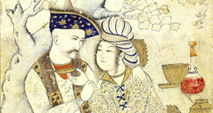The first major exhibition to explore the rule and legacy of Shah Abbas, 'Shah Abbas: The Remaking of Iran', is on display at the British Museum from February 19 to June 14.
The exhibition demonstrates Shah ‘Abbas’ social, religious and artistic influence on Iran through the gifts he endowed to major shrines in Mashhad, Ardabil and Qum, and his magnificent new capital Isfahan. The objects, many of which have not been seen outside Iran, include exquisite Qur’ans, mosque lamps, paintings, carpets, caligraphy, porcelain and silks.
In this piece David Blow, writer and author of a forthcoming book on Shah Abbas looks at the Safavid contribution to the Iranian identity.
David Blow *
No Iranian regime did more to shape the Iranian identity as it is today than that of the Safavids. The first of the Safavid kings, Shah Ismail I, who ruled from 1501 to 1524 CE, re-established Iran as a political entity within its historic borders for the first time since the Arab Muslim conquest in the mid-seventh century CE.
Before the reign of Shah Ismail, the territory of Iran was either divided among two or more powers or else formed part of a larger empire, like the Abbasid caliphate or the empire of Timur. Shah Ismail was also responsible for making Iran the Twelver Shiite country that it has remained ever since.
At the time, the population of Iran was overwhelmingly Sunni, although there were pockets of Shiism in various parts of the country and Shiite minorities in most towns.
The introduction of Shiism was far from being a bloodless affair and many thousands of Iranian Sunnis were either killed or fled to neighbouring Sunni lands. But it was not until the reign of Shah Abbas I, who ruled from 1587 to 1629 CE, that a more or less orthodox Twelver Shiism became the firmly established religion of the state and of most Iranians.
The power of Shah Abbas’s Safavid predecessors rested on the Turkoman tribesmen –known as ‘Qizilbash’ because of the red bonnets they wore – who were followers of the Shah in his capacity as hereditary Sheikh of the Safavid Sufi order.
By creating a standing army of Caucasian slave troops, Shah Abbas put an end both to the Qizilbash domination of the state and to the challenge to orthodox Twelver Shiism represented by their religious outlook, which was a mixture of Shiite extremism and mystical Sufism.
He also established a firm alliance between the Safavid monarchy and the Twelver Shiite ulama, with the Shah promoting and strengthening the Shiite clerical establishment in return for clerical support for Safavid rule. This support was maintained until the overthrow of the Safavid empire by the Afghans in 1722, although there was occasional disquiet at the Safavid shahs’ love of wine and the favour they showed towards Christians – in particular the Armenian community which Shah Abbas I settled in his capital of Isfahan and which dominated the export trade in Iranian silk.
The religious legitimacy of the Safavid shahs was underpinned by their claim to Alid descent through the Seventh Shiite Imam, Musa al-Kazim, which has since been shown to have been fabricated but which was accepted by the ulama and the general population at the time, although the ulama could not accept their further claim to be the representatives on earth of the Hidden Imam.
The later Qajar dynasty attempted to re-establish the Safavid alliance with the clergy but never enjoyed the same degree of legitimacy and increasingly lost the support of the ulama, while the Pahlavis never really sought that support and were overthrown in consequence.
The imposition of Shiism by the Safavids led to long and bitter wars with two of Iran’s powerful Sunni neighbours – the Ottoman Empire in the west and the Uzbek Khanate centred on Bukhara and Samarqand in the east. These wars strengthened the Iranian commitment to Shiism, making it effectively a national cause.
With the third great Sunni power on the borders of Safavid Iran, the Moghul empire in India, there was nothing like the same degree of hostility since the Moghul emperors, for the most part, embraced an altogether more tolerant Sunnism.
But the Safavids, and Shah Abbas I in particular, did not ignore the other and much older aspect of the Iranian identity, which harked back to pre-Islamic times.
At the same time as Shah Abbas promoted great public displays to mark Ashura and other major Shiite and Muslim festivals, he also encouraged the celebration of the ancient Iranian festivals of Mehregan, Chaharshanbe Suri, Abpashan and, above all, of course, Noruz.
He is said to have reintroduced the celebration of Abpashan or Abrizagan, which was instituted in Sasanian times to commemorate the coming of rain after a long period of drought. Under Abbas and his successors, Noruz became the occasion of major official celebrations at the court and in all the main cities.
From Abbas’s reign onwards, there was also much greater stress on the country’s Iranian identity. In the early Safavid period the country was usually referred to as ‘the (God-) protected country’ (mamlekat-e mahrousa), but under Abbas it was more frequently referred to as Iran and Abbas himself as the ruler of Iran (farmanrava-yi Iran, shahryar-i Iran) .
With the overthrow of the Safavid empire, Iran was devastated by many years of anarchy and warfare followed by the humiliation of Anglo-Russian domination over the corrupt government of the Qajars. Inevitably, Iranians looked back on the Safavid period, especially the more peaceful and prosperous seventeenth century, as a Golden Age.
As for the greatest of the Safavid kings, Shah Abbas I, he quickly became a legendary figure. The British envoy to the Qajar court at the beginning of the nineteenth century, Sir John Malcolm, records the esteem in which Abbas was held in the popular memory.
“The modern traveller,’ writes Malcolm, ‘who inquires the name of the founder of any ancient building, receives the ready answer, ‘Shah Abbas the Great’, not from an exact knowledge that he was the founder, but from the habit of considering him the author of every improvement’ Today his great capital of Isfahan remains as much a reminder of the past splendour of Iran as the ruins of Persepolis.
David Blow*
Shah Abbas: The Ruthless King Who Became an Iranian Legend
Emperor of Persia and Restorer of Iran
IBTauris, London


